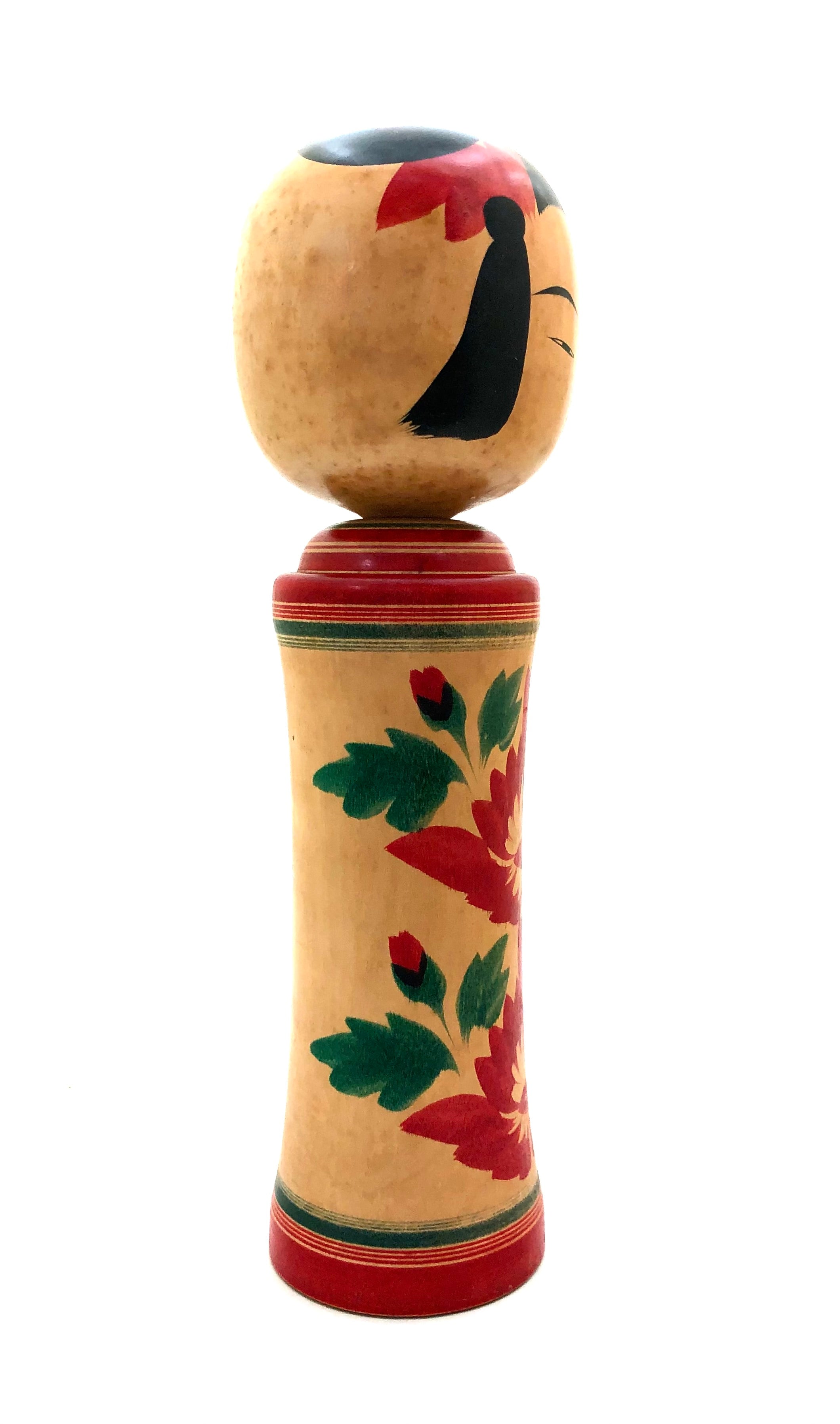


Vintage Japanese Traditional Narugo Kokeshi by Yusa, Fukuju
Dimension: 13-3/4”h
Narugo dolls are one of the most well-known families of Kokeshi, originally came from Narugo Onsen in Miyagi Prefecture, and originated sometime in the Edo period when there were approximately 125 craftsmen producing this style. The Narugo Kokeshi have been labeled the most sophisticated of the Traditional styles.
Here is what makes this Kokeshi beautifully preserved being created in the artists earlier career as a Traditional craftsman. Made by Yusa, Fukui, knowns as a Creative/Sosaku artist was born in Miyagi Prefecture to a very prominent family of Traditional Narugo Kokeshi artists. Yusa-san had a hard time separating himself from the dolls his family produced and while apprenticing under Master Takashashi Sakari of Narugo Spa, Miyagi, where he began creating Sosaku dolls in the late 1950s.
The following are the details of this offering. This Kokeshi is beautifully defined by its straight-shaped body, narrowing slightly at the waist with beveled shoulders. It bangs are well defined and a definitive feature of the head with side fringes, a single eyelid, and a cat nose. Its graphics are well balanced, having chrysanthemum, (Kiku)as the major motif on the body of the doll making the doll visually elegant. The doll is signed on the bottom by Yusa (1930-), and is very collectible for the collector who wants a full perspective of the pieces produced by this artist. In breaking family tradition, he created award- winning dolls in both categories and won the Prime Minister’s Award in 1960, at the age of 30.
NOTE: For more information on this artist go to our Browse & Learn section,https://mingeiarts.com/collections/artisan-woodworker-yusa-fukuju-1930-2001, as well as https://mingeiarts.com/collections/narugo-kei-family, affording you details about this style and artist.
Condition: Excellent condition for the piece is perfect, with no chipping, missing elements or loss of artwork/color which is beautifully defined. It retains a beautiful finish, with its original craftsmanship preserved. Museum-quality: meeting the standards of the collector of Yusa, Fukuju Kokeshi.

Japanese Traditional Kokeshi
Narugo-Kei (Family)
Prefecture: Miyaka
Origin:
This strain of Kokeshi is the oldest family of Narugo from Miyagi Prefecture, founded by Onuma Matagoro in the late Edo period. Naruko Kokeshi is known for its unique body and head shape. These are the popular “squeaking or crying child” dolls and are made of two pieces, with the head being attached to the body via a snap-in projection, allowing it to be turned, thus making the squeak. Naru is "sound or cry," and ko is “child". Thus, Narugo is a "crying child”. It's no surprise, then, that the Naruko Kokeshi makes a crying sound when her head is turned. They originally came from Narugo Onsen in Miyagi Prefecture and originated sometime in the Edo period, when approximately 120 craftsmen were producing this style. The Naruko kokeshi has been labeled the most distinctive and sophisticated. That said, the kanji for Naruko is still commonly seen with the kojin’s signature.
Collector's note – characteristics / painting style:
Narugo dolls are defined by their cylindrical, thick, and straight-shaped bodies, narrowing slightly at the waist with a shoulder-beveled dome called a mori agari bubun. Its head is large and round with narrow (Hitofude), one-stroke eyelids, an iris (Hitoe mabuta), and a slightly arched eyebrow. The nose is known as a cat’s nose, which is small and slightly curved. Its mouth consists of two small curved red lines or a small single red lip. Bangs are set wide apart and are the definitive feature of the head, with bangs over the forehead, side hair fringes, and a red ‘tegara ’- style ribbon. They are also very balanced and typically have paintings of chrysanthemums (Kiku), iris (Ayame), or peonies (Botan), and are occasionally painted black. Though these plain dolls are not as decorative as others of the Traditional school, their unique, flowing forms are stronger visually because of their inherent elegance.
 Leading Craftsmen:
Leading Craftsmen:
Akiyama, Chuichi, 1913-1984 - No additional published information
Hayashaka, Takashi, 1925-2010 - No additional published information
Izu Sadao, 1905-1938, Naruto Liniage. Master: and Reitaro. The eldest son of farmer Izu Kurataro in Ginzan Shinhata, Obanazawa City, Yamagata Prefecture. The owner of Fujiya Inn and the head of the ward, Yamagata Prefecture Woodworking Workshops, were held at the Hayashihachi Inn, where Izu-san learned the techniques of woodturning. After acquiring the techniques, Izu Sadao continued his woodturning work at Ginzan, specializing in making Kokeshi dolls and toys. Takei Takeo sent an order for Kokeshi and toya to Izu Sadao, and the works he acquired in December 1928 were introduced in the "Japanese Folk Toys, Eastern Section." Around 1933 and 1934, Izu installed three foot pedal lathes in his own home, invited Omiya Yasujiro and Endo Kozo as craftsmen, and his father, Izu Kurataro, made a large number of toys and Kokeshi dolls by cutting wood boards. No additional published information
Kakizawa, Koretaka, 1940, (Narugo, Miyagi) - Master:Takahashi, Morio. No additional published information
Kishi, Mason, 1931-2010 - No additional published information
Matsuda, Mitsuo, 1929-2010 - No additional published information
Omiya, Masataka, 1939-1990 - No additional published information
Onuma, Matagoro,1924 - Grand Master Izu Mamoru, 1925, (Master: Izu, Sadao (Obanazawa, Yamagata). No additional published information
Onuma, Kengo, 1937 - (Master :Onuma, Kenzaburo). No additional published information
Samurai, Shoji, 1927-2011 - No additional published information
Sato, Yoshihiro, 1936-2015 - No additional published information
Sugi, Kunio, 1942 - (Master: Takakashi, Takeo). No additional published information
Takahashi Morio, 1917 Master- (Apprenticed under Master: Takahashi, Sakari). No additional published information
Takahashi, Matsuko, 1920-2005 - No additional published information
Takahashi, Takeo, 1916-2005 - (Master: Takashi Takezo). No additional published information
Explore & Learn More about Narugo-Kei (Family)